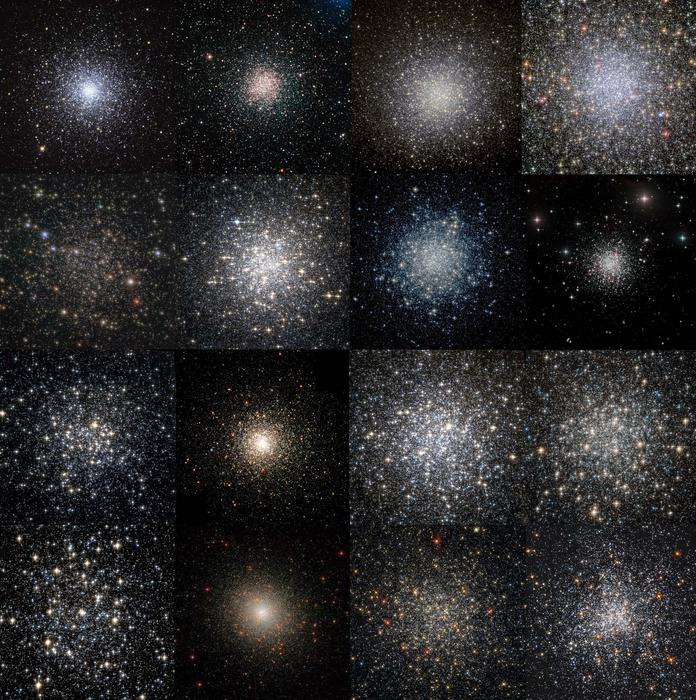A team of scientists from the National Institute for Astrophysics (INAF), the University of Bologna, and Indiana University published a study in Astronomy & Astrophysics that represents a major advancement in the understanding of the development and dynamical evolution of multiple stellar populations in globular clusters. Globular clusters are spherical and extremely compact stellar agglomerates that are usually home to one to two million stars.

Image gallery of the 16 globular clusters analyzed in order of difference in the kinematic properties observed between the multiple stellar populations. Image Credit: ESA/Hubble - ESO - SDSS
This groundbreaking study is the first to conduct a 3D kinematic analysis of multiple stellar populations across a representative sample of 16 globular clusters in the Galaxy.
It offers a novel observational account of their long-term evolution from formation to the present and their kinematic characteristics (i.e., how stars move within globular clusters).
Understanding the physical processes behind the formation and early evolution of globular clusters is one of the most fascinating and debated astrophysical questions of the past 20–25 years. The results of our study provide the first solid evidence that globular clusters formed through multiple star formation events and place fundamental constraints on the dynamical path followed by the clusters throughout their evolution. These results were made possible by a multi-diagnostic approach and the combination of state-of-the-art observations and dynamic simulations.
Emanuele Dalessandro, Study Lead Author and Researcher, National Institute for Astrophysics
The study emphasizes how crucial it is to comprehend the kinematic variations among various populations to comprehend the mechanisms underlying the formation and evolution of these ancient structures.
Globular clusters are some of the earliest systems to form in the Universe, with ages as long as 12–13 billion years, which means they date back to the beginning of the universe. They are a representative sample of all galaxies. They are observable even in distant galaxies and are compact systems with masses of several hundred thousand solar masses and sizes of a few parsecs.
Dalessandro added, “Their astrophysical significance is huge because they not only help us to test cosmological models of the formation of the Universe due to their age but also provide natural laboratories for studying the formation, evolution, and chemical enrichment of galaxies.”
Although globular clusters have been studied for more than a century, recent observational results show that our understanding remains largely incomplete.
Results obtained in the last two decades have unexpectedly shown that globular clusters consist of more than one stellar population: a primordial one, with chemical properties similar to other stars in the Galaxy, and another with anomalous chemical abundances of light elements such as helium, oxygen, sodium, and nitrogen. Despite the large number of observations and theoretical models aimed at characterizing these populations, the mechanisms regulating their formation are still not understood.
Mario Cadelano, Study Author and Researcher, Department of Physics and Astronomy, University of Bologna
The research's basis is the measurement of 3D velocities, or the combination of radial and proper motions, which were acquired using the ESA Gaia telescope and data from the ESO VLT telescope, among other sources. This was done mainly as part of the MIKiS survey (Multi-Instrument Kinematic Survey), a spectroscopic survey designed to investigate the internal kinematics of globular clusters.
These telescopes, both from space and on the ground, have enabled an unparalleled three-dimensional view of the velocity distribution of stars in the chosen globular clusters.
The analysis shows stars with varying light element abundances exhibit distinct kinematic characteristics, including orbital distributions and rotational velocities.
In this work, we analyzed in detail the motion of thousands of stars within each cluster. It quickly became clear that stars belonging to different populations have distinct kinematic properties: stars with anomalous chemical composition tend to rotate faster than the others within the cluster and progressively spread from the central regions to the outer ones.
Alessandro Della Croce, PhD Student, National Institute for Astrophysics
The dynamical age of globular clusters determines how strong these kinematic differences are.
Dalessandro added, “These results are consistent with the long-term dynamical evolution of stellar systems, in which stars with anomalous chemical abundances form more centrally concentrated and rotate more rapidly than the standard ones. This, in turn, suggests that globular clusters formed through multiple star formation episodes and provides an important piece of information in defining the physical processes and timescales underlying the formation and evolution of massive stellar clusters.”
This new three-dimensional view of star motion within globular clusters provides an unprecedented and intriguing framework for the formation and dynamical evolution of these fascinating systems. It also aids in the resolution of some of the trickiest riddles pertaining to the genesis of these ancient structures.
Journal Reference:
Dalessandro, E. et. al. (2024) A 3D view of multiple populations’ kinematics in Galactic globular clusters. Astronomy & Astrophysics. doi.org/10.1051/0004-6361/202451054